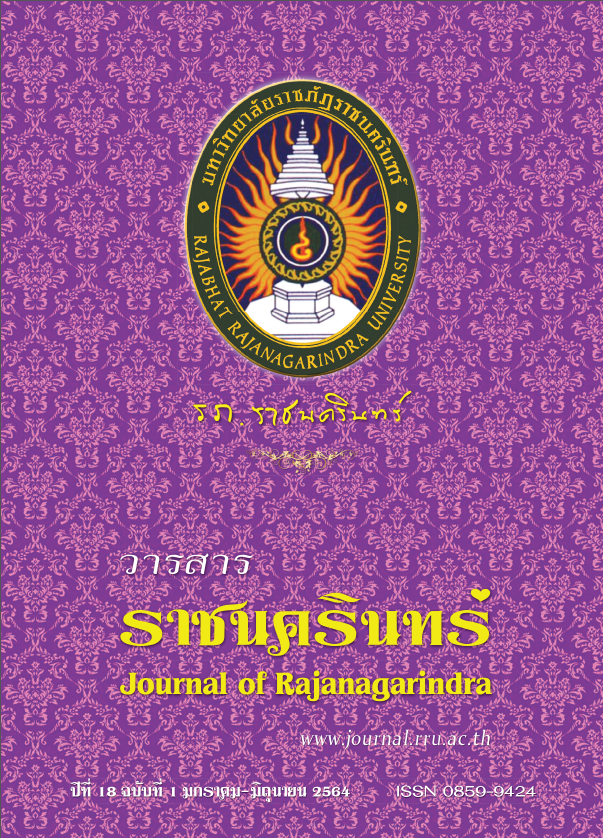The Development of CLODS Instructional Model for the Application to Solve the Problems of Trigonometric Functions under Additional Mathematics Course (MA 32201) in Mathematics Learning Strand for Mathayom Suksa 5
Keywords:
CLODS instructional model, Problem solvingAbstract
The objectives of this research were to develop the CLODS instructional model for the application to solve problems of trigonometric functions under Additional Mathematics Course (MA 32201) in Mathematics Learning Strand and to study the efficiency of using the developed CLODS instructional model for the application to solve problems of trigonometric functions under Additional Mathematics Course (MA 32201) in Mathematics Learning Strand. The sample was 30 Mathayom Suksa 5/2 students in the first semester, academic year 2020 at Sap Nok Kaeo Witthaya School under Sa Kaeo Provincial Administrative Organization. The sample was selected based on a cluster random sampling. The results indicated that the developed CLODS instructional model for the application to solve problems of trigonometric functions under Additional Mathematics Course (MA 32201) in Mathematics Learning Strand consisted of important components, namely: principles and concepts, purpose, instructional process, and measurement and evaluation. The instructional process contained five steps: Check Knowledge (C), Learn together (L), Operative (O), Discussion and examination (D), and Summary and evaluation (S). The experimental results of using the developed CLODS instructional model revealed that the learning achievement at post-experiment period was higher than pre-experiment period with a statistical significance level of .05. The sample’s problem-solving ability after taught with the developed CLODS instructional model was at a very good level at 78.80. which exceeded the set criteria at 75%. The sample’s opinions towards the developed CLODS instructional model was at the highest level (mean= 4.53, S.D. = 0.52).
References
ชมนาด เชื้อสุวรรณทวี. (2555). การพัฒนารูปแบบ การเรียนการสอนคณิตศาสตร์ที่ส่งเสริมความสามารถในการคิดขั้นสูงและจิตตนิสัยของ นักเรียนระดับมัธยมศึกษา. วิทยานิพนธ์ปรัชญาดุษฎีบัณฑิต. นครปฐม : มหาวิทยาศิลปากร.
ชมพูนุท รุ่งสว่าง. (2558). ผลการจัดกิจกรรมการเรียนรู้ด้วยรูปแบบการเรียนรู้แบบสืบสวนสอบสวนที่มีต่อความสามารถในการแก้ปัญหาและการให้เหตุผลทางคณิตศาสตร์ เรื่อง การประยุกต์ฟังก์ชันตรีโกณมิติ ของนักเรียนชั้นมัธยมศึกษาปีที่ 5. วิทยานิพนธ์การศึกษามหาบัณฑิต สาขาวิชาการสอนคณิตศาสตร์ คณะศึกษาศาสตร์ มหาวิทยาลัยบูรพา.
ทิศนา แขมมณี. (2556). ศาสตร์การสอน : องค์ความรู้เพื่อการจัดกระบวนการเรียนรู้ที่มีประสิทธิภาพ. พิมพ์ครั้ง 17. กรุงเทพฯ : สำนักพิมพ์แห่งจุฬาลงกรณ์มหาวิทยาลัย.
วัชรา เล่าเรียนดี. (2555). รูปแบบและกลยุทธ์การจัดการเรียนรู้เพื่อพัฒนาทักษะการคิด. พิมพ์ครั้งที่ 9. นครปฐม : โรงพิมพ์มหาวิทยาลัยศิลปากร วิทยาเขตพระราชวังสนามจันทร์.
สถาบันส่งเสริมการสอนวิทยาศาสตร์และเทคโนโลยี. (2559). สรุปผลการวิจัย PISA 2015 วิทยาศาสตร์ การอ่าน และคณิตศาสตร์. กรุงเทพฯ : สถาบันส่งเสริมการสอนวิทยาศาสตร์และเทคโนโลยี (สสวท).
การประชุมวิชาการระดับชาติ ครั้งที่ 1 ในหัวข้อ “การจัดการศึกษาเพื่อพัฒนาท้องถิ่นสู่ประชาคมอาเซียน : ทิศทางใหม่ในศตวรรษที่ 21” วันที่ 28 กรกฎาคม 2559 ณ อาคารเรียนรวมและปฏิบัติการเทคโนโลยีสารสนเทศ มหาวิทยาลัยกาฬสินธุ์, 763 - 774.
สำนักวิชาการและมาตรฐานการศึกษา. (2560). ตัวชี้วัดและสาระการเรียนรู้แกนกลางกลุ่มสาระการเรียนรู้คณิตศาสตร์ (ฉบับปรับปรุง )พ.ศ. 2560) ตามหลักสูตรแกนกลางการศึกษาขั้นพื้นฐาน พุทธศักราช 2551. กรุงเทพฯ : โรงพิมพ์ชุมนุมสหกรณ์การเกษตรแห่งประเทศไทย.
เสาวลักษณ์ บุญจันทร์. (2558). ความสามารถในการแก้ปัญหาทางคณิตศาสตร์ ของนักเรียนชั้นมัธยมศึกษาปีที่ 5 เรื่อง กฎของไซน์และโคไซน์ ที่สอนโดยใช้กระบวนการคิดเชิงเมตาคอกนิชัน. วิทยานิพนธ์วิทยาศาสตรมหาบัณฑิต สาขาวิชาคณิตศาสตร์ศึกษา มหาวิทยาลัยบูรพา.
Joyce, B. & Weil, M. (2000). Model of teaching. 6th ed. Boston : Allyn and Bacon




